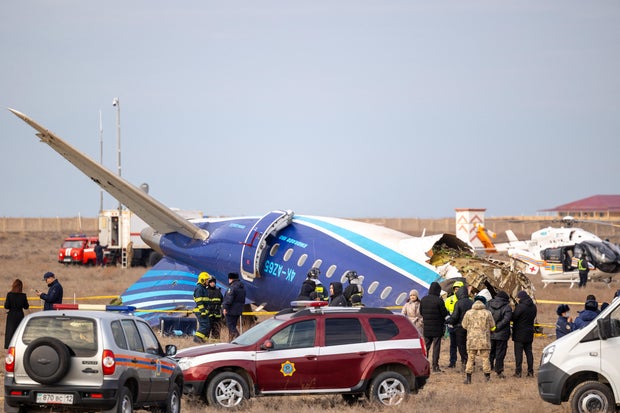Officials are trying to find out what caused the Azerbaijan Airlines plane crash in Kazakhstan on Christmas Day which killed 38 people on board, leaving 29 people alive, as speculation is mounting that the Russian military he could have played a role in the accident.
Here's what we know so far:
How did the plane crash?
Azerbaijan Airlines Flight 8243, an Embraer 190 aircraft, was flying from the Azerbaijani capital Baku to the city of Grozny in the North Caucasus region on Wednesday when it was diverted for reasons that are not yet fully clear.
It happened while he was trying to reach another airport in Aktau, in the west of Kazakhstan.
Mobile phone footage appears to show the plane descending steeply before hitting the ground and exploding in a fireball about two miles from Aktau airport.
Pictures from the scene show the rear part of the plane's fuselage still intact after the crash, lying upside down in a field.
ISSA TAZHENBAYEV/AFP via Getty Images
The airline said there were 67 people on board – 62 passengers and five crew members – and 38 people died in the crash, but 29 of those on board survived.
Investigators have recovered two so-called black boxes, flight data and cockpit voice recorders, from the crash site.
Why did the plane change course?
There were conflicting accounts as to why the plane's pilots diverted the plane.
Russia's civil aviation authority, Rosaviatsia, initially said the pilots appeared to have flown to Aktau after the bird strike. Later, Russian and Azerbaijani officials suggested that the plane was turned back because of fog or bad weather in Grozny. Then Russia also claimed that Ukrainian drones targeting the Grozny region were a factor.
Murat Usubali/Anadolu via Getty Images
Speaking at a press conference on Wednesday, Azerbaijani President Ilham Aliyev said that although it was too early to know the cause of the crash, bad weather had forced the plane to change from its intended course.
“The information given to me is that the plane changed its course between Baku and Grozny due to bad weather and went to Aktau airport, where it happened when it landed,” said e.
Dmitry Yadrov, head of Rosaviatsia, said on Friday that as the plane was preparing to land in Grozny in deep fog, Ukrainian drones targeted the city, forcing authorities to close the area. your air traffic.
Yadrov said that after the captain made two unsuccessful attempts to land, he was offered other airports but decided to fly to Aktau in Kazakhstan, across the Caspian Sea, instead.
What do aviation officials and experts say about a possible cause?
Kazakhstan, Azerbaijan and Russia have all opened investigations into the cause of the crash. The Kremlin has urged it people not jumping to conclusions.
In a statement on Friday, December 27, Azerbaijan Airlines said the plane had “external physical and technical interference,” but did not say where it believed the interference came from or not. he provided more information. They announced the suspension of flights to several Russian airports.
A US official told CBS News that there were early indications that a Russian anti-aircraft system may have shot down the plane in an area where Ukrainian and Russian forces have traded fire drone and rocket for months. The official, who spoke on the condition of anonymity, said that if that was confirmed, it would emphasize Russia's recklessness in its continued existence. invasion of Ukraine.
White House National Security Council spokesman John Kirby said on Friday that US officials “have seen some early indications that would definitely indicate that this jet could be brought down by air defense systems of Russia.”
He confirmed to reporters that the US has intelligence or information indicating a possibility, but said that Kazakhstan and Azerbaijan are currently conducting the investigation and that the US would “respect that process.” “
Meiramgul Kussanova/Anadolu via Getty Images
Meanwhile, independent aviation experts are casting doubt on the bird strike theory, with some pointing to the damage seen on the plane's fuselage as evidence that it may have caught fire.
“It certainly doesn't look like a flock of birds,” said CBS News aviation safety analyst Robert Sumwalt, former chairman of the National Transportation Safety Board.
“Birds do not fly at the altitude that caused the original damage to this aircraft,” Sumwalt said.
Yan Matveyev, an independent Russian military expert, noted that images of the downed plane's tail show damage consistent with shrapnel from small surface-to-air missiles, such as the Pantsyr air defense system. S1.
“It appears that the tail section of the aircraft was damaged by missile fragments,” he said.
Speaking to reporters on a December 27 conference call, Kremlin spokesman Dmitry Peskov declined to comment on the allegations of possible Russian involvement in the accident, saying that it is up to investigators to determine the cause.
The survivors heard sounds before the crash
Passengers and crew who survived the crash told Azerbaijani media that they heard loud noises on the plane as it circled over Grozny.
Flight attendant Aydan Rahimli said that after one sound, the oxygen masks were released automatically. She said she went to administer first aid to her colleague, Zulfugar Asadov, and then they heard another bang.
Kazakhstan Ministry of Emergencies Press Service via AP
Asadov said the sounds sounded like something hitting the plane from outside. Soon after, he was wounded suddenly, like “a deep wound, his arm was hit as if someone hit me in the arm with an axe,” he said. He denied an allegation by Kazakh officials that an oxygen canister exploded inside the plane.
Two other survivors said they heard the explosion before the plane went down: Jerova Salihat told Azerbaijani television in an interview at the hospital that “something exploded” near her leg, and Vafa Shabanova said “there were two explosions in the sky, and an hour and a half later the plane fell to the ground.”
Chris Livesay and
contributed to this report.









